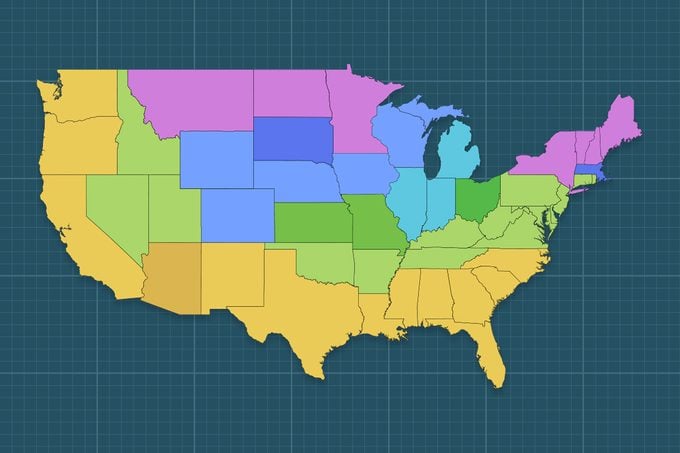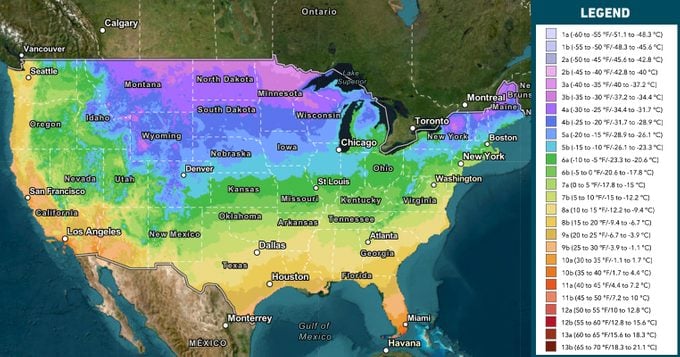Learning your Plant Hardiness Zone will help you choose plants that will grow well in your garden and avoid those that might not survive.
What Is a Plant Hardiness Zone and How Do I Find Mine?

When gardeners from different parts of the United States meet up, one common question we ask each other is, “What’s your Plant Hardiness Zone?” That leads to some inevitable scratching of heads when someone from Indiana learns some areas of New Mexico share the same Hardiness Zone as their garden.
But can they grow the same plants? Maybe … but also maybe not.
On This Page
What Is a Plant Hardiness Zone?

A Plant Hardiness Zone is defined by the average coldest temperature. The zones can be found on the United States Department of Agriculture Plant Hardiness Zone Map, updated in 2023.
The current map is based on the average lowest winter temperatures from 1991 to 2020. The U.S. is broken into 13 zones, changing every 10 degrees. Each zone is also divided into an A area, covering the lower five degrees of the zone, and a B area, covering the highest five degrees.
The USDA zone map is just for the U.S. Other countries maintain their own based on their own criteria.
It’s helpful to know the approximate zones in other countries, especially when reading books written by British gardeners. Great Britain overall has a warmer climate with a longer, cooler growing season than many areas of the U.S.. One source for this information is Plantmaps.
How To Know Which Zone You Live In
It’s easy: Just visit the United States Department of Agriculture Plant Hardiness Zone Map. Click on the link, select ‘View Maps’ and enter your address. This will zoom the map to your location. Match the color of the map to the same color in the chart on the right to determine your zone.
Why Should I Know My Plant Hardiness Zone?
Knowing your Plant Hardiness Zone gives you some of the information you need before purchasing plants. Sticking with plants hardy enough to grow in your zone increases their chances of thriving in your garden.
This is especially important with modern gardening, because you can find so many plants for sale online. Some online merchants will ask you for your address so they can determine your Hardiness Zone, and warn you before you make a mistake. But others will say nothing and ship you any plant you want, even if it isn’t likely to grow in your garden. You can waste a lot of money that way.
What Other Factors Affect Plant Hardiness?
While Plant Hardiness Zones generally determine if a plant will thrive in a particular location, other factors can affect that as well:
- Summer heat: The American Horticulture Society developed a heat zone map dividing the country into 12 zones, based how many days exceed 86 degree in an average year. More vendors are listing heat tolerance on plant labels.
- Annual rainfall: Two regions in the same Hardiness Zone can still vary widely in the amount of rain they get, affecting which plants will thrive there.
- Winter snow cover: Snow is a natural insulator, so plants covered with snow may survive colder temperatures than those that are bare.
What Are Microclimates?
Microclimates are areas in a garden that may be warmer or colder than the rest of it. An area next to a brick wall on the south side of a building may warm up faster in the winter and never get quite as cold as the opposite, shadier side.
When you observe your garden and determine the various microclimates, experiment with plants that normally wouldn’t grow in your Hardiness Zone to see if they’ll survive there.
What Are Zone Pushers?
Some gardeners, aka zone pushers, like to try to grow plants that aren’t quite hardy enough for their Plant Hardiness Zone. At some point, most gardeners try to push their zones for that one special plant they really want to grow.
Zone pushers have many methods for keeping less-than-hardy plants growing, including:
- Wrapping plants in burlap to keep winter winds from drying them out.
- Insulating the root zone with a thick layer of mulch or shredded leaves.
- Digging up these plants and overwintering them in an unheated space that stays above freezing.
- Finding the perfect microclimate where they can grow as though in a warmer zone.




















